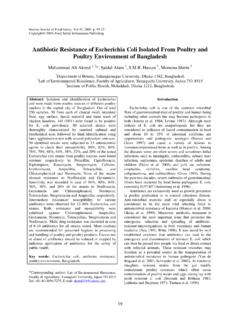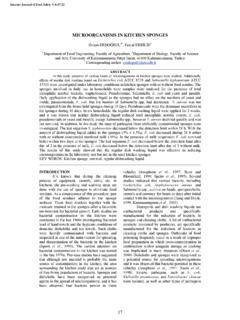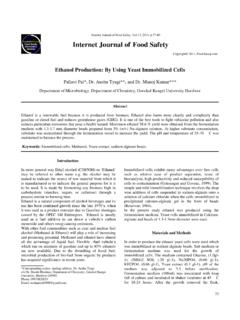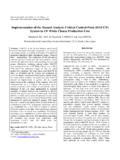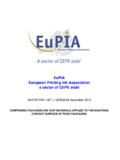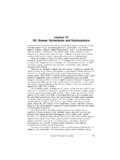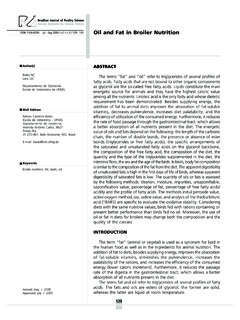Transcription of Industrial Application of Lipases in Cheese Making: …
1 293 Internet Journal of Food Safety, , 2011, Internet Journal of Food Safety Copyright 2011, Food Industrial Application of Lipases in Cheese Making: A review Mahmoud El-Hofi, El-Sayed El-Tanboly and N. S. Abd-Rabou iry Science Department, National Research Center, Dokki, Cairo, Egypt. Abstract Lipases are extensively used in the dairy industry for the hydrolysis of milk fat. The dairy industry uses Lipases to modify the fatty acid chain lengths, to enhance the flavours of various cheeses.
2 Current applications also include the acceleration of Cheese ripening and the lipolysis of butter, fat and cream. The free fatty acids generated by the action of Lipases on milk fat endow many dairy products, particularly soft cheeses with their specific flavor characteristics. Lipolysis is an important biochemical event occurring during Cheese ripening and has been studied quite extensively in varieties such as Blue and hard Italian cheeses where lipolysis reaches high levels and is a major pathway for flavour generation.
3 However, in the case of cheeses such as Cheddar and Gouda, in which levels of lipolysis are moderate during ripening, the contribution of lipolytic end products to Cheese quality and flavour has received relatively little attention. The progress of lipolysis and its effect on flavour development during Cheese ripening is reviewed. FFA are important precursors of catabolic reactions, which produce compounds that are volatile and contribute to flavour. The aim of this work is to review the existing knowledge of the way in which lipolysis and FFA catabolism proceed during Cheese ripening, how lipolysis may be measured and monitored and also how this biochemical event contributes to Cheese flavour.
4 Key words: Lipolysis; Cheese ripening; Catabolic products; Flavour Introduction Lipases (EC ) are enzymes that catalyse the hydrolysis of triglycerides (triacylglycerols), the major lipid components of milk. This hydrolysis is commonly referred to as lipolysis. The products of the reaction are free, or nonesterified fatty acids, and partial glycerides (mono- and diglycerides) and, in some cases, glycerol. By definition, Lipases act at the lipid water interface of emulsions of longchain, insoluble triglycerides, while the related esterases act on esters of short-chain fatty acids (and other * Email: acids) and soluble esters (Jaeger et al.)
5 , 1994). The significance of lipolysis in milk is two-fold: flavor production and altered functionality. Free fatty acids (FFAs), particularly those of short and medium chain length, have strong flavours that, in most cases, are considered undesirable. The flavour of whole milk with an elevated FFA level, mmol L-1, is unacceptable to most people (IDF, 1987) and is variously described as rancid, butyric, astringent or even bitter, although this last flavour is usually attributable to products of proteolysis not lipolysis.
6 The term rancid is also used to describe the off-flavour due to lipid oxidation. In general, oxidative and hydrolytic rancidities are not related, although there is some evidence that FFAs are more susceptible to oxidation than the parent triglycerides. Flavours due to lipolysed fat can also be desirable; some cheeses such as certain hard Italian and Blue varieties owe their characteristic flavour to the presence of FFAs (Deeth & Fitz-Gerald, 1995). A major functionality effect of lipolysis in milk is depression of its foaming ability when injected with steam 294 demonstrates the relationship between foaming capacity (steam frothing value) and degree of lipolysis (as FFA).
7 This effect is manifested in difficulty in producing acceptable foam when making cappuccino coffee. It is due to the partial glycerides produced during lipolysis, which are surface active and displace the foam-stabilizing proteins at the air water interface of the foam bubbles. Some other functionality defects, such as impaired creaming ability during separation and increased churning time in the manufacture of butter, have been reported (Deeth & Fitz-Gerald, 1995).
8 Sources of Lipases 1. Animal Lipases The most animal Lipases from Porcine Pancreas (EC ) are derived from kid-goats, lambs, and/or calves sources. The component that animal lipase is made from is generally proprietary, but sources in literature say drying and grinding of pre-gastric glands at the base of the calves tongues. 2. Microbial Lipases The lipase/esterase system of Lactic Acid Bacteria (LAB) has received much less attention then their proteolytic. Lactococcus sp.
9 Are only weakly lipolytic, but lactococci may be responsible for the liberation of quite high levels of FFA when present in high cell numbers or over extended ripening periods. Lipase/esterase of Lactococcus strains, which appear to be intercellular, have been studied (Chich et al., 1997). Obligately homofermentative lactobacilli used as starter (Lb. helveticus, Lb. delbrueckii subsp. bulgaricus and Lb. delbrueckii subsp. lactis) also produce esterase, some of which have been studied (El-Soda et al.)
10 , 1986; Gobbetti et al., 1996 and Khalid et al., 1990). Facultatively heterofermentative lactobacilli ( , Lb. casei, Lb. paracasei and Lb. plantarum) (Gobbetti et al., 1997). Table 5 describes the use of lipase in Cheese making and accelerated Cheese ripening. The free fatty acids take part in simple chemical reactions that initiate the synthesis of other flavour ingredients, such as acetoacetate, b-keto acids, methyl ketones, flavour esters and lactones. 3. Plant Lipases Lipases from plants are broadly classified into: 1- Triacylglycerol Lipases (EC ) or true Lipases that hydrolyze the ester bonds of storage triacylgycerols of seeds, such as oilseeds and cereal grains.


